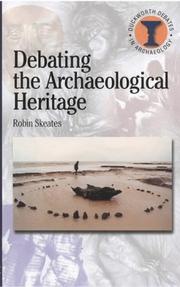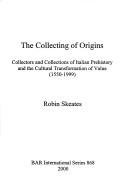| Listing 1 - 9 of 9 |
Sort by
|
Book
ISBN: 9780199216604 Year: 2010 Publisher: Oxford Oxford University Press
Abstract | Keywords | Export | Availability | Bookmark
 Loading...
Loading...Choose an application
- Reference Manager
- EndNote
- RefWorks (Direct export to RefWorks)
Excavations (Archaeology) --- Prehistoric peoples --- Senses and sensation --- Social archaeology --- Sensation --- Sensory biology --- Sensory systems --- Knowledge, Theory of --- Neurophysiology --- Psychophysiology --- Perception --- Cavemen (Prehistoric peoples) --- Early man --- Man, Prehistoric --- Prehistoric archaeology --- Prehistoric human beings --- Prehistoric humans --- Prehistory --- Human beings --- Antiquities, Prehistoric --- Archaeological digs --- Archaeological excavations --- Digs (Archaeology) --- Excavation sites (Archaeology) --- Ruins --- Sites, Excavation (Archaeology) --- Archaeology --- Methodology --- Malta --- Antiquities. --- Primitive societies

ISBN: 0715629565 9780715629567 Year: 2000 Publisher: London Duckworth
Abstract | Keywords | Export | Availability | Bookmark
 Loading...
Loading...Choose an application
- Reference Manager
- EndNote
- RefWorks (Direct export to RefWorks)
monumentenzorg --- archaeology --- historic preservation --- Conservation. Restoration --- archeologie --- Archeology --- bouwkundig erfgoed --- architectural heritage --- Antiquities --- Cultural policy. --- Cultural property --- Historic preservation. --- Historic sites --- Landscape protection. --- Collection and preservation. --- Protection. --- Conservation and restoration.

ISBN: 1841711446 Year: 2000 Publisher: Oxford : British archaeological reports,
Abstract | Keywords | Export | Availability | Bookmark
 Loading...
Loading...Choose an application
- Reference Manager
- EndNote
- RefWorks (Direct export to RefWorks)
Antiquities, Prehistoric --- Archaeological museums and collections --- Collectors and collecting. --- History.
Book
Year: 2017 Publisher: Cambridge Cambridge University Press
Abstract | Keywords | Export | Availability | Bookmark
 Loading...
Loading...Choose an application
- Reference Manager
- EndNote
- RefWorks (Direct export to RefWorks)
Animal husbandry --- Archeology --- archaeozoology --- animal husbandry [discipline] --- Roman [ancient Italian culture or period]
Book
ISBN: 1003341888 1003341888 1000784665 100078469X 9781000784664 9781138026223 1138026220 9781138026230 1138026239 Year: 2017 Publisher: London ; New York : Routledge,
Abstract | Keywords | Export | Availability | Bookmark
 Loading...
Loading...Choose an application
- Reference Manager
- EndNote
- RefWorks (Direct export to RefWorks)
Archaeology and state. --- Antiquities --- Archaeology --- Cultural property --- Collection and preservation. --- Social aspects. --- Protection. --- Archäologie --- Funde --- Gesellschaft --- Archaeology and state --- Museum. --- Archäologie. --- Collection and preservation --- Protection --- Social aspects
Book
ISBN: 9781138676299 1138676292 9781032337777 9781315560175 Year: 2022 Publisher: London Routledge, Taylor & Francis Group
Abstract | Keywords | Export | Availability | Bookmark
 Loading...
Loading...Choose an application
- Reference Manager
- EndNote
- RefWorks (Direct export to RefWorks)
Edited by two pioneers in the field of sensory archaeology, this Handbook comprises a key point of reference for the ever-expanding field of sensory archaeology.0This Handbook provides an extensive set of specially commissioned chapters, each of which summarizes and critically reflects on progress made in this dynamic field during the early years of the twenty-first century. The authors identify and discuss the key current concepts and debates of sensory archaeology, providing overviews and commentaries on its methods and its place in interdisciplinary sensual culture studies. Through a set of thematic studies, they explore diverse sensorial practices, contexts and materials, and offer a selection of archaeological case-studies from different parts of the world. In the light of this, the research methods now being brought into the service of sensory archaeology are re-examined.
Archaeology --- Senses and sensation. --- Sensation --- Archéologie --- Sens et sensations. --- Methodology. --- Méthodologie. --- Archeology --- History of civilization
Book
ISBN: 131719747X 1317197461 1315560178 Year: 2019 Publisher: Milton : Routledge,
Abstract | Keywords | Export | Availability | Bookmark
 Loading...
Loading...Choose an application
- Reference Manager
- EndNote
- RefWorks (Direct export to RefWorks)
Edited by two pioneers in the field of sensory archaeology, this Handbook comprises a key point of reference for the ever-expanding field of sensory archaeology: one that surpasses previous books in this field, both in scope and critical intent. This Handbook provides an extensive set of specially commissioned chapters, each of which summarizes and critically reflects on progress made in this dynamic field during the early years of the twenty-first century. The authors identify and discuss the key current concepts and debates of sensory archaeology, providing overviews and commentaries on its methods and its place in interdisciplinary sensual culture studies. Through a set of thematic studies, they explore diverse sensorial practices, contexts and materials, and offer a selection of archaeological case-studies from different parts of the world. In the light of this, the research methods now being brought into the service of sensory archaeology are re-examined. Of interest to scholars, students and others with an interest in archaeology around the world, this book will be invaluable to archaeologists and is also of relevance to scholars working in disciplines contributing to sensory studies: aesthetics, anthropology, architecture, art history, communication studies, history (including history of science), geography, literary and cultural studies, material culture studies, museology, philosophy, psychology, and sociology.
Book
ISBN: 9781842174746 1842174746 9781842179475 1842179470 Year: 2012 Publisher: Oxford Oxbow Books
Abstract | Keywords | Export | Availability | Bookmark
 Loading...
Loading...Choose an application
- Reference Manager
- EndNote
- RefWorks (Direct export to RefWorks)
Caves in Context provides the thriving inter-disciplinary field of cave studies with a European-scale survey of current research in cave archaeology. It is unified by a contemporary theoretical emphasis on the cultural significance and diversity of caves over space and time. Caves and rockshelters are found all over Europe, and have frequently been occupied by human groups, from prehistory right up to the present day. Some appear to have only traces of short occupations, while others contain deep cultural deposits, indicating longer and multiple occupations. Above all, there is great variabili
Caves --- History. --- Caverns --- Grottoes --- Rock shelters --- Rockshelters --- Landforms --- Speleology --- History
Book
ISBN: 9780199237821 0199237824 Year: 2012 Publisher: Oxford Oxford University Press
Abstract | Keywords | Export | Availability | Bookmark
 Loading...
Loading...Choose an application
- Reference Manager
- EndNote
- RefWorks (Direct export to RefWorks)
Archeology --- Archaeology and state --- Archaeology and state. --- Archaeology --- Salvage archaeology. --- Social aspects. --- Archaeology and state - Handbooks, manuals, etc.
| Listing 1 - 9 of 9 |
Sort by
|

 Search
Search Feedback
Feedback About UniCat
About UniCat  Help
Help News
News